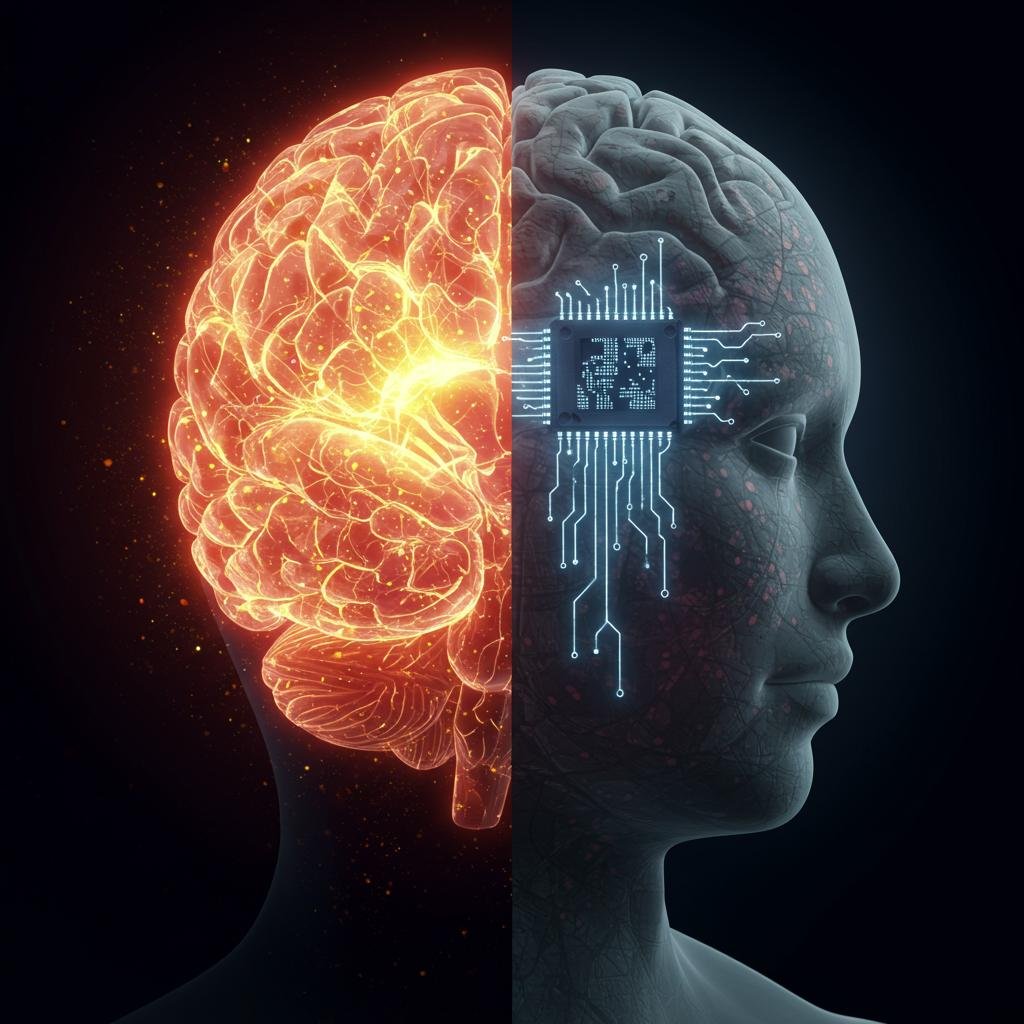Cognitive Atrophy: Is Your Team's Over-Reliance on AI a Ticking Time Bomb?
June 23, 2025
AI promises unprecedented productivity, but at what cost? This article explores ‘cognitive offloading’ and the very real danger that using AI as a crutch, rather than a tool, is weakening your team’s core creative and critical thinking skills. Learn how to prevent this cognitive atrophy and turn AI into a true partner for innovation.
The Productivity Paradox: Gaining Speed, Losing Brainpower
The race is on. Across every industry, businesses are scrambling to integrate Artificial Intelligence into their workflows. We’re using it to write code, generate financial reports, draft marketing copy, and supercharge our efficiency. The promise is intoxicating: do more, faster. But as we chase these short-term productivity gains, are we unknowingly creating a long-term “cognitive debt”?
Think of the brain as a muscle. Like any muscle, it needs resistance and regular workouts to stay strong. The act of thinking—of struggling with a problem, recalling information, or creating something new—is its primary form of exercise. Now, enter AI. When we hand over these core thinking tasks, a process known as ‘cognitive offloading’, we’re essentially skipping our mental workout. Do it once, it’s a convenience. Do it every day, and that muscle begins to atrophy.
This article moves beyond the hype to address a real, strategic threat posed by the misuse of AI. The danger isn’t the technology itself. The danger is our all-too-human tendency to take the path of least resistance, turning a potentially powerful partner into a cognitive crutch that could leave our teams weaker, less innovative, and ultimately less competitive.

The Science of ‘Cognitive Offloading’: When Your Brain Goes on Autopilot
‘Cognitive offloading’ isn’t a new phenomenon, but its scale and scope with AI are unprecedented. In simple business terms, it’s the act of outsourcing mental tasks—remembering, planning, analyzing, creating—to an external system.
We’ve seen earlier versions of this play out. How many phone numbers do you have memorized now compared to the pre-smartphone era? How has GPS impacted your innate sense of direction or your ability to navigate by map and landmark? For many, the skill has diminished because the need for it was removed.
The underlying neuroscience is straightforward. When you actively work to recall a fact, solve a problem, or structure an argument, your brain forms and strengthens neural pathways. It’s a demanding process that builds mental resilience and capacity. When you prompt an AI to “summarize this report” or “give me five ideas,” you bypass this entire neurological workout. Your brain receives the output without performing the labor. The result? The neural connections responsible for that type of thinking don’t get exercised, and over time, they weaken.
This isn’t just a personal problem; it’s a profound organizational risk. A team that consistently offloads its foundational thinking loses the ability to innovate from first principles. It becomes dependent on the machine not just for speed, but for the very act of cognition itself.
The ROI of Laziness: Homogenized Ideas and Fading Creativity
When cognitive offloading becomes standard practice, the “return on investment” starts to look grim. The direct consequences of AI over-reliance manifest as tangible business liabilities.
Creativity & Innovation: Generative AI models are trained on vast datasets of existing human-created content. By their very nature, they are designed to produce statistically probable, or ‘average’, outputs. When your team relies on AI for brainstorming, they risk producing homogenized strategies, vanilla marketing campaigns, and “me-too” product ideas that blend in rather than stand out. True breakthroughs come from non-obvious connections, a feat of human ingenuity that AI struggles to replicate.
Critical Thinking & Problem Solving: The most valuable part of solving a problem is often the struggle. The process of analyzing data, identifying constraints, debating approaches, and synthesizing a solution is where true learning and skill-building happen. When an AI simply provides the answer, your team is robbed of this crucial process. Their ability to tackle novel, complex problems—the kind that don’t have a pre-existing answer in a training dataset—erodes with every shortcut taken.
Memory & Institutional Knowledge: Relying on AI to summarize meetings or retrieve information prevents employees from internalizing knowledge. Instead of team members building a deep, personal understanding of projects, strategies, and client histories, that knowledge remains externalized. This creates a fragile ‘corporate memory’ that exists only as long as the queries are run. Your organization’s most valuable asset—its collective intelligence—is never truly embedded in its people.

From Cognitive Crutch to Workout Partner: A New Mandate for AI Interaction
So, how do we reap the benefits of AI without succumbing to cognitive atrophy? We must fundamentally reframe our relationship with the technology. Stop seeing AI as a magic box that delivers finished answers. Start treating it as a sophisticated workout partner.
A great workout partner doesn’t lift the weights for you. They spot you, challenge your form, and push you to attempt one more rep. They make the workout harder, and that’s why it’s effective. We must demand the same of our AI.
This new model requires discipline and a shift in how we prompt and interact. Here are a few concrete examples:
Instead of:
Write a blog post about the challenges of remote work.Use this:
Act as a sparring partner. Here is my first draft of a blog post on remote work. My core argument is [your argument]. Challenge my assumptions, point out logical fallacies, and suggest three counterarguments I haven't considered.Instead of:
Give me 10 ideas for a marketing campaign for our new SaaS product.Use this:
I've developed three initial concepts for a marketing campaign: [Concept A, B, C]. For each one, help me brainstorm potential weaknesses, identify the target audience that would be *least* receptive, and suggest an unexpected channel to reach them.Instead of:
Summarize this 20-page research document.Use this:
I've read this document and my key takeaway is that the market is shifting towards hyper-personalization. Check my understanding against the source material and highlight any nuances or contradictory data points I might have missed.
This approach uses AI to augment and stimulate human thought, not replace it. It forces the user to do the initial heavy lifting, turning the AI’s output into a catalyst for deeper thinking rather than a substitute for it.

Leading the Charge: How to Build a Cognitively Strong, AI-Powered Organization
As a leader, you set the cultural tone for technology use. Preventing cognitive atrophy requires a deliberate, top-down strategy. Here’s how you can lead the charge:
Establish ‘Mindful AI Usage’ Policies: Don’t ban AI—guide it. Create clear company guidelines that encourage active engagement. Mandate that raw AI-generated text or ideas cannot be used as a final product. Require that employees show how they’ve verified, challenged, and built upon the AI’s initial output.
Train for Augmentation, Not Replacement: Your AI training shouldn’t just be about “how to get answers faster.” Focus on teaching prompt engineering that stimulates critical thinking. Run workshops on how to use AI as a devil’s advocate, a research assistant, and a creative foil. Teach your team to question, verify, and add unique value to every AI interaction.
Measure and Reward Deep Thinking: If you only reward speed and volume, you are implicitly encouraging cognitive offloading. Shift performance metrics to value the quality, originality, and insightfulness of the work. Publicly praise and reward employees who demonstrate strong first-principles thinking and who use AI to elevate their work to a new level, not just to complete it faster.
Lead by Example: This is the most critical step. Managers and executives must model this behavior. When you present a new strategy, talk about how you used AI as a sparring partner to test your assumptions. Share your “bad” AI-generated ideas and the thought process that led you to a better, human-driven conclusion. Show, don’t just tell, that thinking is the most valued activity in your organization.
Your Team’s Greatest Asset is Between Their Ears. Protect It.
The core argument is simple: unchecked, lazy AI use leads to cognitive atrophy. The path of least resistance is a path to diminished organizational capability. In the race for efficiency, we risk sacrificing the very ingenuity that makes our businesses valuable.
The only sustainable competitive advantage in the age of AI will be a team that can think critically, creatively, and originally. This requires a new, disciplined approach to technology—one where we treat AI not as a comfortable crutch, but as a demanding workout partner that pushes us to become stronger.
Don’t let short-term productivity gains erode your long-term intellectual capital. Azlo.pro helps organizations develop strategies to integrate technology that enhances, rather than replaces, human ingenuity. Let’s build a smarter future, together.